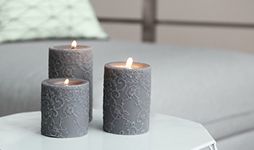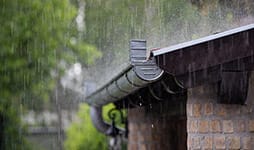In this guide we reveal what damp is and the various types you might encounter. You'll also learn some practical tips on spotting and dealing with damp.
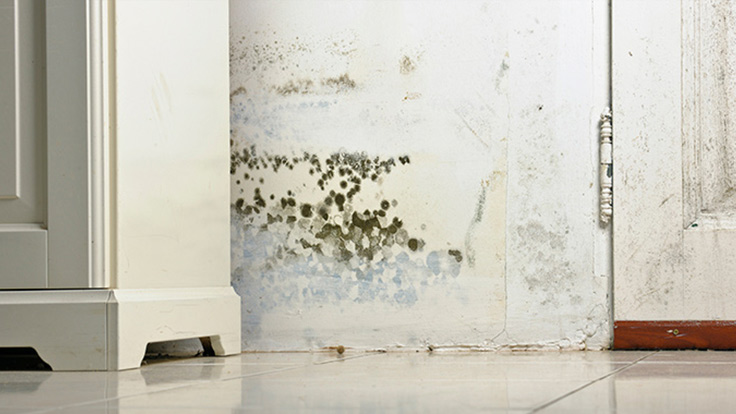
What is damp?
Damp is when there's too much moisture in your home. High levels of of moisture can cause many problems if it's not dealt with.
Patches of moisture, discolouration, and a musty smell can all be tell-tale signs of damp.
Ignoring damp is not a good idea. It can damage walls and window frames, and lead to health or respiratory problems.
Is damp covered by home insurance?
Many insurers, including us, don't cover damage from damp. We also don't cover damage from fungus, mould, condensation and frost.
This is because these issues typically occur over time. They therefore fall under the policy exclusion 'maintenance and normal use or ageing'.
The worse the damp issue gets, the more expensive it'll likely be to repair the damage.
What causes damp?
Damp can be caused by:
- Faulty pipes, guttering or drainage
- Blocked vents and air bricks
- Rising damp from cellars
- Rainwater through roofs or windows
- High levels of ground around the property, such as soil or paving materials banked up against exterior walls
Signs of damp in a property
You may smell damp before you see the visible signs. These are some of the things to look out for:
- Stains or patches of mould on walls
- A musty smell
- Excessive condensation on windows
- Peeling wallpaper
- Paint blisters
- Crumbling plaster work
Types of damp
There are 3 types of damp; rising damp, penetrating damp and condensation. You'll need to treat each one differently, so it's important to know what you're dealing with. Let's take a look at these in more detail to help you identify the potential cause.
Rising damp
What is rising damp?
Rising damp is a type of damp that affects the walls of buildings. It occurs when moisture from the ground travels up through the walls by capillary action. This means that ground water is sucked up through tiny tubes in the bricks, like a series of straws.
You'll usually start to notice it on lower parts of walls, concrete floors and floorboards. Wet weather makes rising damp worse as walls have more water to soak up.
Modern houses are usually constructed with a damp-proof membrane under concrete flooring. This is often referred to as a ‘damp-proof course’.
What are the signs of rising damp?
- Appearance of damp stains and patches on walls
- Ironwork showing signs of rust
- Loose or rotting flooring or skirting boards
- Crumbling, flaky or salt-encrusted plaster-work
How to fix rising damp
You might want to call a professional to fit or replace a damp-proof course. If you spot a few wet patches on the floor, painting the floor with a waterproof emulsion could suffice.
The damp-proof course in the walls should be set to a height of 15cm. If there are any wet patches above this height on an exterior wall, it's worth checking the other side. Sometimes a raised path or piles of damp earth prove to be the culprits.
Penetrating damp
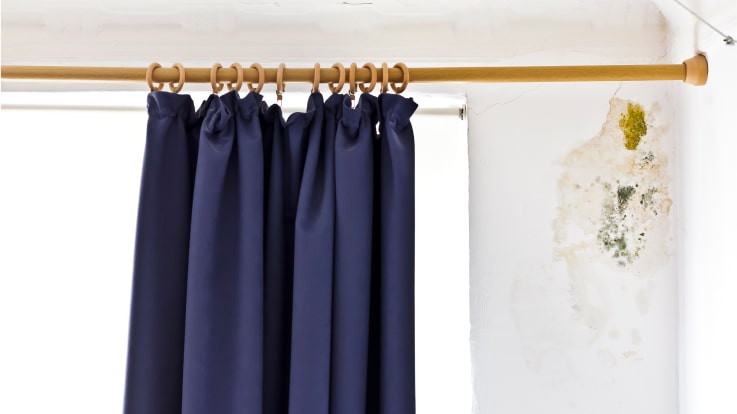
What is penetrating damp?
Penetrating damp happens when water gets into a building through walls or roofs. This leads to wet patches and mould. It can damage the inside of your property.
What are the signs of penetrating damp?
- Drips or puddles
- Peeling wallpaper
- Crumbling plaster work
- Patches that turn dark during rain
- Increasing damp circles on walls, floors and ceilings
How to fix penetrating damp
It's a good idea to call in a professional. They'll be able to check for the potential cause, which can include:
- Leaky pipes: Inspect plumbing for any leaks or water damage
- Guttering issues: Ensure that gutters are not broken or blocked, allowing proper drainage
- Roof condition: Examine for missing or damaged roof tiles that may let water in
- Wall cracks: Check for cracks in walls, as they can be entry points for water
- Window and door seals: Check these are properly sealed to prevent water infiltration
- Flashing and joints: Examine flashing around structures and unsealed joints for any issues
Condensation
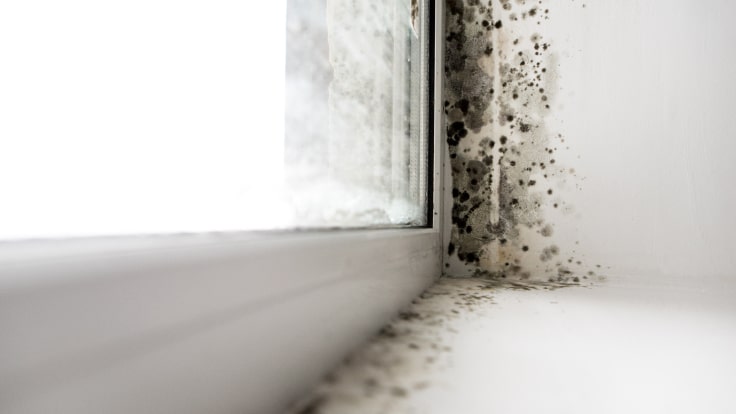
What is condensation?
Condensation is where warm indoor air meets a cold surface and turns into liquid. Think of it like when your cold drink gets droplets on the outside of the glass. In the home, this moisture can sometimes soak into window frames, causing them to rot, or into the walls.
What are the signs of condensation?
- Water found on windows or walls
- Rotting and stained window frames
- Peeling wallpaper
- Musty smell
- Spread of mould on fabrics, such as carpets and curtains
How to reduce condensation
Better ventilation, including opening windows or window trickle vents can reduce condensation.
Double glazing and good insulation are effective too. This is because they prevent walls and window panes getting too cold.
Fitting vents and using air bricks can also help prevent the build-up of moisture.
Failing all that, consider using a dehumidifier. This is a device that removes excess moisture from the air.
It's worth checking for areas where condensation can build up unnoticed. Like a sealed fireplace, chimney, lofts or basements.
Damp on outside walls
Damp on outer walls can have various origins, often linked to external issues.
These can be leaks caused by damaged roofs or flashing. Or from clogs in gutters due to tree debris, and wear and tear of masonry, render, or mortar. Older brickwork may become absorbent, and cracks can worsen the problem.
Overgrown plants or uncleared debris can also contribute to damp on external walls.
How to prevent damp
There are some simple and practical ways to prevent damp. Most of these you can carry out yourself, including:
Ensuring rooms are well ventilated
- Clearing debris around the property
- Regularly checking roofing (do this safely to avoid putting yourself in any danger)
- Making sure all vents are clear, particularly in kitchens and bathrooms
- Making sure kitchens are properly ventilated when cooking
- Regularly airing your home by opening windows and doors
- Using a dehumidifier to extract moisture
How to spot damp when viewing a house
There are some tell-tale signs of damp to look out for, from damp patches to musty smells. However, these may be hidden or covered up, so it's crucial to ask the right questions to the seller or agent.
Consider opting for a home-buyer survey too. This can provide insights into potential damp issues. The issues a survey should pick up can include deteriorating roofs or brick pointing.
What is mould and mildew?
Mould is fungi which grows outwards in green or black filaments. It can grow on damp surfaces like bathroom walls and trim around windows.
Mould can be bad for your health. Especially dangerous for those who suffer from asthma or other respiratory conditions. It can also cause allergic reactions that may affect the eyes, nose, throat or lungs.
Mildew is fungi, usually grey in colour and can smell musty. Look closely and you’ll see a flat or thin layer of filaments. It can be found on damp surfaces from bathrooms to cellars, carpets and curtains.
Mildew can be hazardous to health, either by touch or inhalation.
How to remove mould and mildew from walls
Natural solutions include vinegar, distilled in a bottle, and sprayed onto the surface. Then leave for an hour, before returning to scrub the mould or mildew off. This should work for smaller surface areas.
If the problem is more widespread, consult a trusted tradesperson.
How to prevent mould from returning
Once you’ve made the effort of getting rid of mould, here are 6 ways to stop it returning.
- Wash and disinfect surfaces that suffer from mould
- Fix internal or external causes of leaks
- Maintain ventilation and open windows
- Clear any rubbish and debris
- Use a dehumidifier and clean extractor fans
- Clean and dry carpets
The sooner you identify signs of damp, the easier it'll be to get rid of. We trust this guide will help you deal with troublesome damp issues for a safe and healthy home.
Learn more about home insurance
Home insurance covers your buildings, contents and personal possessions. So you'll benefit from peace of mind if the unexpected happens.


